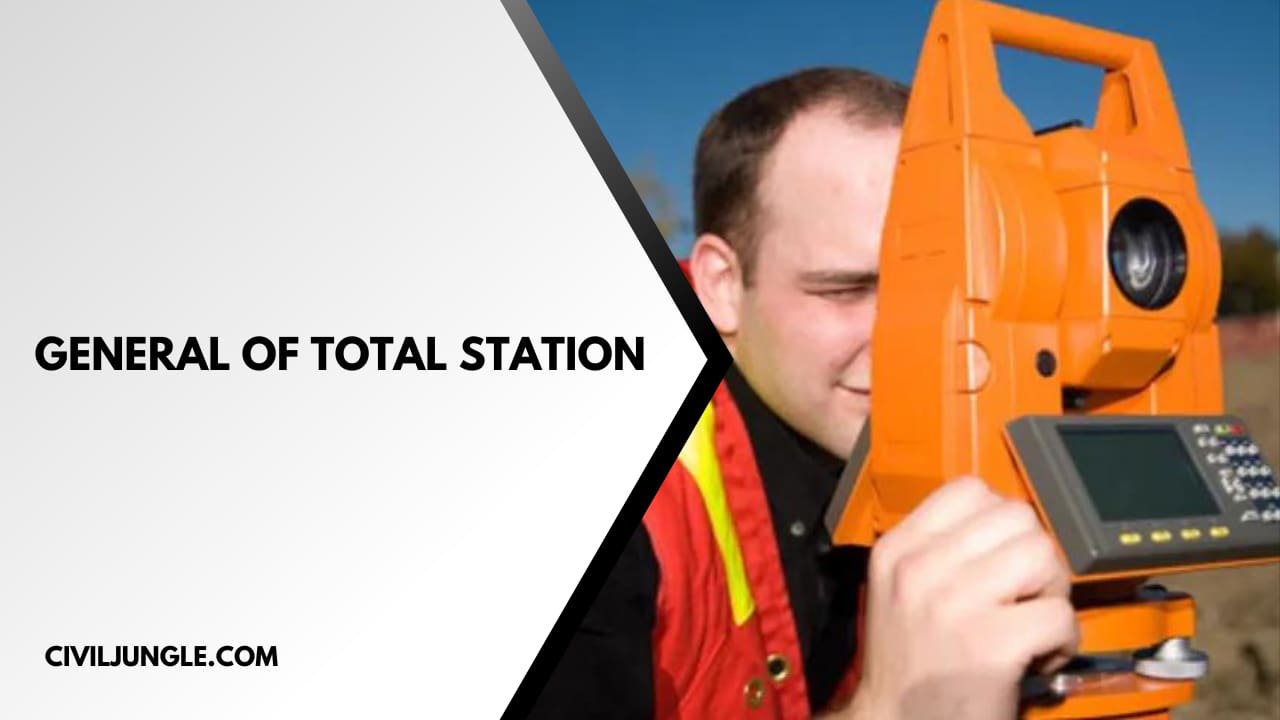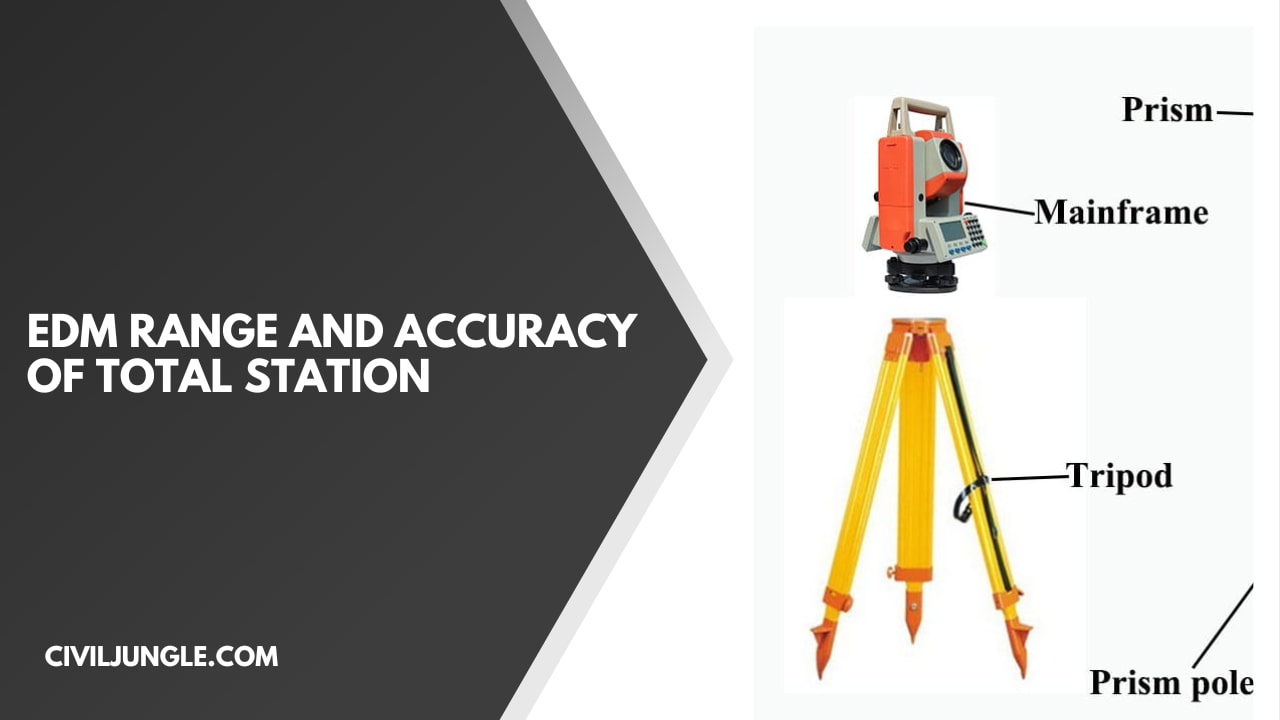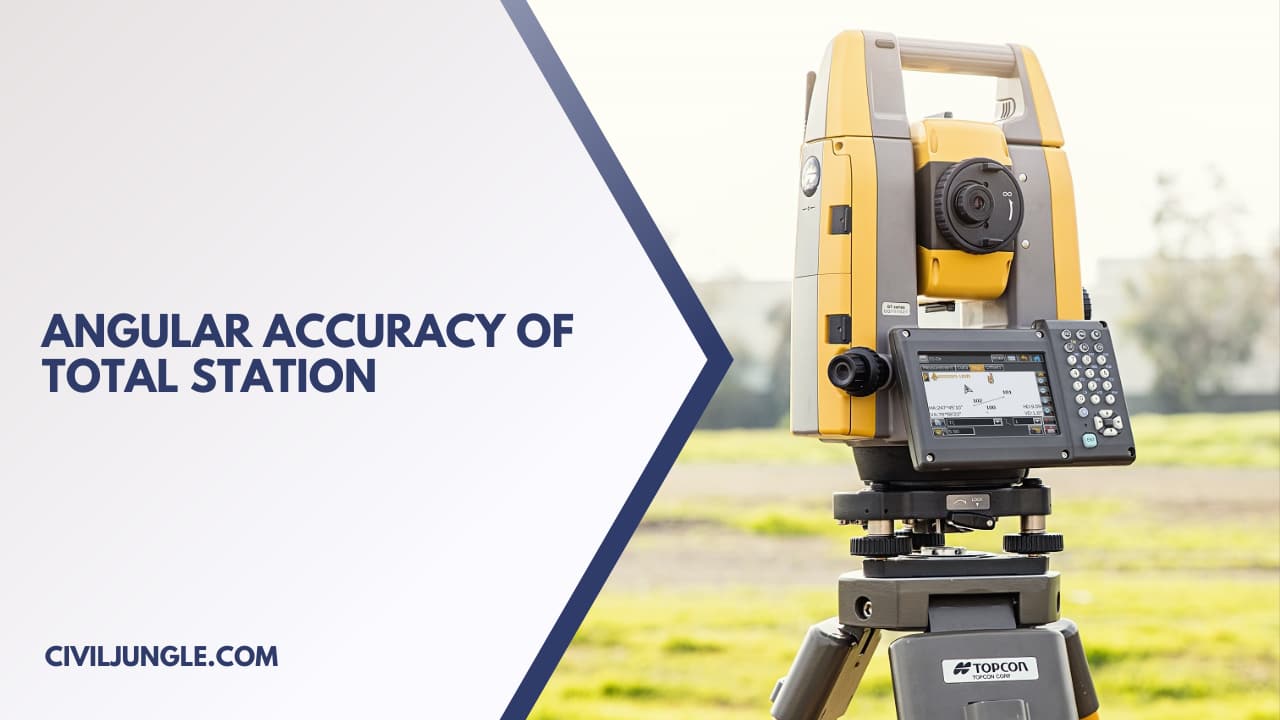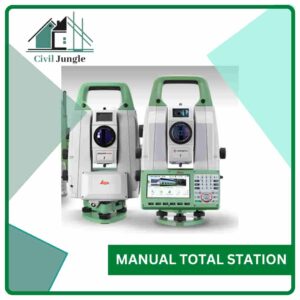What Is a Total Station in Surveying?
Important Point
The most frequently used surveying instrument today is the total station (As per below figure No1). An entire station is a combination of a digital theodolite, an electronic distance measuring device (EDM) and a microprocessor with a memory unit.
Total Station Figure No 1
The digital theodolite, initially introduced in the late 1960s by Carl Zeiss Inc., helped to set the platform for modem field data collection and processing.
When the Digital theodolite has been used with a built-in electronic distance-measuring unit, the birth of this new concept in fully automated surveying started.
The name for an instrument of this type was electronic tacheometer, but Hewlett-Packard introduced the name total station more than 30 years ago, along with the name immediately caught on with the profession (As per below figure No 2 & 3).
First Total Station Figure No 2
Old Total Station Figure No 3
With this device, one can determine angles and distances from the instrument to the points to be surveyed. With the aid of trigonometry, the distances and angles may be utilized to calculate the real positions (x, y, and z or northing,) of surveyed points in total terms.
Also, read: What Is Transit Theodolite | Theodolite Parts
Why Is Use Total Station in Surveying?
This discussion provides general guidance on the use of total stations on topographic surveys. It includes info on reflectorless/robotic systems and prism-only systems. Use and operation of external and internal data collectors using a total station are covered.
Operations of Total Station
- There are less than a dozen producers of total stations that generally market in the United States.
- Each maker may have varied models, together with optional features which may be tailored to local working conditions, such as accuracy requirements, project size (EDM distances), and also accessible crew size.
- Selection of a particular model, together with the associated data collector and CADD software, requires some study.
- A good place to being is viewing periodic surveys by trade publications.
- Discussions with users at other engineers and surveyors, local survey suppliers, and AE survey builders are will also be recommended.
- Exhibitor demonstrations in state survey society meetings is another good place to observe and test new equipment.
- Sometimes, vendors will offer to come to the district and exhibit their own equipment on your local operating environment
Also, read: Principle of Plane Table Surveying Methods |Equipment | Error | Advantage | Limitation
General of Total Station
- Total station survey are conducted similarly to transit stadia or plane table alidade surveys.
- Total stations are installed over control points similarly to traditional transits, theodolites, or EDM.
- Most use a three-screw, forced-centering Wild-type tribrach bracket to fasten and align the total station together with the tripod.
- Heavy fiberglass or wooden tripods are ideal for supporting total stations. Leveling above a point is done no more than traditional instrument procedures.
- The tribrach is about centered over the point first utilizing the standard tripod leg modification technique.
- The total station is then mounted at the three-pin tribrach and internally leveled with either level vials or digital dual-axis methods, depending on the kind of the instrument.
- Either laser or analog plummets are utilized for final centering within a point.
- Some total stations provide from level warnings to the operator.
- All plummets, optical or electronic, should occasionally be checked, adjusted, and calibrated.
- A traditional plumb bob provides this type of check if utilized in ideal conditions.
Prism Poles of Total Station
- An assortment of target poles is used for the remote rod to that topographic observations are created.
- Both flexible and fixed height poles are common to see according to figure No 4 below. Extendable rods (to 20 ft and higher) could be used especially on beach profiling surveys and in canopy areas.
Prism Pole
- For most programs, a retro-reflector prism is attached to the top of the prism pole such that there isn’t any eccentric offset correction demanded.
- Otherwise, then the retro-reflector offset correction has to be determined and implemented to found spaces.
- Utilization of a fixed height pole helps reduces HR blunders.
- A shoe to the pole point could is required in soft ground. A normal rod level is utilized to interrogate the prism pole above a point.
- Many poles have built-in rod levels to ease plumbing the prism.
Also, read: Piling for Foundation | Use of Pile Foundation | Characteristics of Pile Foundation
EDM Range and Accuracy of Total Station
- Ranges with standard prisms and reflectorless version differ widely between manufacturers.
- Both laser and infrared EDMs are utilized. Distance resolution is either pulsed (low precision) or phase comparison (average -± 2 to t 5 millimeter(mm) accuracy).
- One and three array prism ranges may vary from one mile to over 5 miles.
- Ranges of reflectorless total stations are given relative to 90% and 18% Kodak grey cards and may vary from 300 feet to over 3000 feet.
- Reflectorless accuracies aren’t as good as prism accuracies given this variability of the reflecting terrain, and can, therefore, might not be suitable for more accurate surveys like FEMA first floor elevation certifications.
- In the outer range limitations, bicycle reflector tape (chain)or a prism rod with a retroreflector could be required.
Instrument Controls of Total Station
- Focus and plate management tangent and locking screws vary widely between total station brands.
- A 30X optical zoom is not uncommon on many total stations.
- These controls must be operated in compliance with the manufacturer’s instructions.
Also, read: Test for Compressive Strength of Brick | Water Absorption | Dimensions Test
Angular Accuracy of Total Station
- Angle typical errors range from t 1″ to t 5″ according to a Direct and Reverse set. More accurate versions are offered for construction design application–e.g., 1-minute instruments.
Other Features of Total Station
- Additional things to be considered in the range of a particular total station include robotic search controllers, measurement time, integrated laser scanners, integrated GPS, internal digital camera, internal data storage capability, inner COGO and stakeout capacities. Compatibility with present data collectors (if not purchased with the total station), such as (including batteries and battery life), simplicity of performance, and training requirements.
Also Read: Leveling in Surveying
Advantage & Disadvantage of Total Station
Advantage of Total Station
- Quick setting of this instrument on the tripod with laser plummet
- On-board area computation program to calculate the area of the field
- Greater accuracy in area computation due to the possibility of taking arcs in area computation
- Graphical view of land and plots and for quick visualization
- Coding to perform automatic mapping. whenever the field jobs are finished, the map of this area with dimensions is ready after information transfer
- Tremendous plotting and area computation in any user necessary scale
- Integration of database (exporting the map to GIS packages)
- Automation of old maps
- Full GIS creation (using Mapinfo software)
- Local language support
Disadvantage of Total Station
- Their usage doesn’t offer hard copies of field notes. Hence, it could be difficult for the surveyor to look over and assess the work whilst surveying.
- For a general check of this survey, it is going to be necessary to come back to the office and prepare the drawings utilizing appropriate software.
- They shouldn’t be used for observations of the sun, unless special filters, like the Troelof’s prism, are utilized. Otherwise, the EDM part of this instrument will be damaged.
- The instrument is costly, and also for conducting surveys with a total station, skilled personnel is necessary.
Also, read: What Is Traversing in Surveying | Types | Method | Definition
Types of Total Station
- Manual Total Station
- Semiautomatic Total Station
- Automatic Total Station
- Servo Driven and Robotic Total Station
- Servo Driven Total Station
#1. Manual Total Station-
Manual Total Stations It was necessary to read the horizontal and vertical angles manually in this type of instrument. The single value that may be read digitally was that slope distances.
#2. Semi-Automatic Total Station-
Semiautomatic Total Stations The user needed to manually read the horizontal circle for all these instruments, but the vertical ring readings have been displayed.
Slope distances were measured electronically, and also the instruments could, generally, be used to reduce the values to vertical and horizontal components.
Also, read: What is Chain Surveying (Principal, Procedure, Method, Instrument)
#3. Automatic Total Station-
This type is the most usual total station used today. They feel both the vertical and horizontal angles electronically and measure the slope distances, compute the vertical and horizontal components of those these spaces, and then determine the coordinates of observed points.
To compute the coordinates of observed points, it is necessary to properly orient the instrument to some known directions such as true north, magnetic north or to some known bearing. The coordinate information obtained can either be stored in the total station’s memory or by using an external data collector.
Almost all total stations in the market use infrared as the carrier for distance measurement. The less expensive unit with a single prism reflector can measure distances up to 1000 m.
Those in the higher price range are capable of measuring distances up to 2000 m when single prisms are used. The accuracies of measurements with the less expensive instruments probably run about 6(5 mm 1 5 ppm), and the expensive total stations can run about 6(1 mm 1 1 ppm).
#4. Servo Driven and Robotic Total Station-
Refinements to existing technology are the classes of servo-driven and robotic optical total stations. Their importance in the last few years is seen to be steadily increasing.
Their added functionality makes them suitable for intense mapping. Because of their capacity to improve the surveying operation significantly, they can be classified into a separate group.
Also, read: First Angle Projection & Third Angle Projection Symbol (Orthographic Projection)
#5. Servo Driven Total Station-
Servo-driven instruments are particularly appealing where automatic pointing is desired. This is done by using motors to aim and position the instrument.
In the case of setting out, it makes it feasible to set control points for surveying with very little sighting through the telescope.
When used with the data collection software, the pre-determined coordinates of the point, which have been selected after setting up the instrument and making an observation to the backsight point, are used to automatically set the horizontal and vertical angles of the instrument.
In the case of traversing or other control survey functions, the servo drives can be used to point the instrument in the direction of the next target of the observing program, requiring only fine pointing adjustments by hand.
When these instruments are used manually, because they are servo-driven, they have friction clutches that afford great speed in point, as there are no locks to be adjusted.
Furthermore, fine pointing is aided by having unlimited travel in the manually, because they are servo-driven, they have friction clutches that afford great speed in point, as there are no locks to be adjusted.
Furthermore, fine pointing is aided by having unlimited travel in the tangent screws. Again, because of the servo-driven design, the limit stops of the fine motion screws no longer can exist.
The servo-driven instrument has the disadvantage of data collection and coding occurring at the instrument. It’s also mandatory that at least two people be on the crew. Still, tremendous productivity gains have been reported.
Total Station:
A total station theodolite is an electronic/optical instrument used for surveying and building construction.
Total Station Surveys:
A total station is an optical surveying instrument that uses electronics to calculate angles and distances. It combines the functions of a theodolite with that of a transit level and electronic distance meter (EDM). It also has an integrated microprocessor, electronic data collector, and storage system that allows measurements to be stored on the device (which can be uploaded to a computer for further processing).
How to Use Total Station?
How to use a total station steps are as follows.
- Step 1: Gather the Survey Equipment, Stake, and Tools.
- Step 2: Establish a New Temporary Benchmark.
- Step 3: Set-up the Tripod.
- Step 4: Attach the Tribrach and Coarse Level the Tripod Over the Benchmark.
- Step 5: Continue to Level and Adjust the Tribrach As Necessary.
- Step 6: Set the Instrument on the Tripod.
Uses of Total Station:
A total station is an optical instrument commonly used in construction, surveying and civil engineering. It is useful for measuring horizontal angles, vertical angles, and distance – it does this by analyzing the slope between itself and a specific point.
Surveying Total Stations:
A total station is an optical surveying instrument that uses electronics to calculate angles and distances. It combines the functions of a theodolite with that of a transit level and electronic distance meter (EDM)..
Theodolite Vs Total Station:
A Theodolite is a instrument for measuring both horizontal and vertical angles, as used in triangulation networks. The measurements are typically recorded by hand as they are not recorded by a computer or data collector. Total Stations. A total station is an optical instrument used in modern surveying.
Surveying Instruments and Their Uses:
The main pieces of surveying equipment in use around the world are the following: theodolite, measuring tape, total station, 3D scanners, GPS/GNSS, level and rod. Most survey instruments screw onto a tripod when in use. Analog or digital tape measures are often used for measurement of smaller distances.
How to Read Survey Stationing?
\The first number is the stationing that is ending. The next number is the beginning station number. Any point pertaining to a project may be located on the ground and on the plans by its Station and the number of feet (Offset) LEFT or RIGHT of the Survey C/L.
How to Use Theodolite?
- Mark the point at which the theodolite will be set up with a surveyor’s nail or a stake.
- Set up the tripod.
- Drive the tripod legs into the ground using the brackets on the sides of each leg.
- Mount the theodolite by placing it atop the tripod, and screw it in place with the mounting knob.
Advantages of Total Station:
The advantages of total station are as follows.
- Field work is carried out very fast.
- Accuracy of measurement is high.
- Manual errors involved in reading and recording are eliminated.
- Calculation of coordinates is very fast and accurate.
- Computers can be employed for map making and plotting contour and cross-sections.
Disadvantages of total station:
- The instrument is costlier than other conventional surveying instruments.
- It might be troublesome for the surveyor to investigate and check the work when surveying.
- Working with the total station is not so easy, as more skilled surveyors are required to conduct a total station survey.
What Is Total Station?
A total station is a modern surveying instrument that combines electronic theodolite (an instrument used for measuring horizontal and vertical angles) with an electronic distance meter (EDM) to measure both angles and distances. The total station allows surveyors to measure a series of points on the earth’s surface, which are then used to create detailed maps and plans.
What Is Total Station Survey?
Total stations are the primary survey instrument used in mining surveying. A total station is used to record the absolute location of the tunnel walls, ceilings (backs), and floors as the drifts of an underground mine are driven.
What Is a Total Station in Surveying?
A total station is an electronic/optical instrument used in modern surveying and building construction that uses electronic transit theodolite in conjunction with electronic distance meter (EDM). It is also integrated with microprocessor, electronic data collector and storage system.
Total Station in Surveying
Total stations can be used to measure angles and distances to a high degree of accuracy, typically within a few millimeters. This makes them an essential tool for a wide range of surveying applications, including land surveys, construction projects, and engineering design.
Total Station
Total stations are widely used in surveying and construction projects, including land surveys, engineering design, and building construction. They are an essential tool for creating detailed maps and plans, measuring terrain, and ensuring the accurate placement of structures and infrastructure.
Types of Total Station
As per Trimble Geospatial, there are the following four types of Total Stations;
- Scanning Total Stations.
- Robotic Total Stations.
- Autolock Total Stations.
- Total Mechanical Stations.
Total Station Surveying
Total station surveying is widely used in a variety of applications, including land surveys, construction projects, and engineering design. It is also used in mining, geological surveys, and environmental studies.
Components of Total Station
Parts of the total station
- Handle.
- Handle securing screw.
- Data input/output terminal (Remove handle to view)
- Instrument height mark.
- Battery cover.
- Operation panel.
- Tribrach clamp (SET300S/500S/600S: Shifting clamp)
- Base plate.
Common Features of Total Station Are
Features of Total Station
- (a) Angle Measurement : An electronic theodolite of a total station is used to measure angles.
- (b) Distance Measurement.
- #Standard or Coarse Mode.
- #Precise or Fine Mode.
- #Tracking or Fast Mode.
- (c) Control Panel.
- (d) Power Supply:
Total Station Uses
- Land surveying
- Construction
- Engineering design
- Mining
- Environmental studies
Total Station Used in Surveying
Land surveying: Total stations are commonly used in land surveying to measure distances and angles between points on the earth’s surface. This data is used to create accurate maps and plans, and to establish property boundaries.
To Measure the Bearing Automatically Are Needed to Input in Total Station.
To measure the bearing automatically, you do not necessarily need to input data into a total station. A total station can measure the bearing automatically by using its internal compass or by tracking the position of the prism or reflector.
Function of Total Station
- Angle measurement
- Distance measurement
- Coordinate calculation
- Data storage
Like this post? Share it with your friends!
Suggested Read –
- Types of Tunnel
- Introduction of Gantry Girder | Load on Gantry Gutter | Types of Load on Gantry Gutter
- What Is Dry Pack Mortar | Advantages of Dry Pack Mortar | Disadvantages of Dry Pack Mortar
- What Is Unit Weight | What Is Density | What Is Unit Weight Material | Unit Weight Building Materials
- What Is Pier Foundation | Types of Drilled Piers | Advantages and Disadvantages of Drilled Pier Foundations
- What Is Diversion of Headworks (Rivers) | Types of Diversion Headworks | Component Parts of Diversion Headworks (Rivers)
Originally posted 2023-04-27 17:10:35.






















Wow! Great Piece of Information. We have also tried to give a little brief about the Total Station. Please visit – https://www.skippertech.com/total-station/
EXCELLENT
Thanks, sir